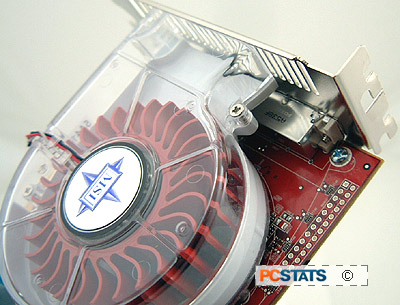The ATi Radeon X1800 XT Video Processing Unit
(VPU) is built on TSMC's 0.09 micron manufacturing process (90nm) and contains a massive 321 million transistors. The Radeon X1800 XT
and X1800 XL videocards each use identical VPU's, however, the Radeon X1800 XT's silicon
adheres to "a higher quality." This is why the Radeon X1800 XT is clocked higher
at stock speeds than most Radeon X1800 XL VPUs can reach when overclocked.
 The ATI Radeon X1800 XT 'R520' core has sixteen pixel rendering pipelines as well
as sixteen texture units, render backends, and Z-Compare units. It can handle up to 512
threads.
The ATI Radeon X1800 XT 'R520' core has sixteen pixel rendering pipelines as well
as sixteen texture units, render backends, and Z-Compare units. It can handle up to 512
threads.
The R520 core comes clocked at 625 MHz,
while the 512MB of Samsung 1.2ns GDDR3 memory runs at a blistering 1.5 GHz, or
1500MHz.
One of the biggest new features of the ATI Radeon X1000 series
VPUs is that it brings in Shader Model 3.0 support across the board; from low to
high end graphics chips.
nVIDIA was previously the only vendor that supported
SM3.0, so the inclusion of this technology levels the playing field once
more. Lack of SM3.0 support was a major knock against previous ATi videocards
so we're glad to see ATI taking steps to wipe out the disparity.
That lack of SM3.0 support was somewhat understandable because the
R480 was based on the previous R423 core, and that VPU which did not support the
feature because games in those days did not use SM 3.0.... Perhaps following on
nVIDIA's PureVideo lead, the videocard also comes with a bit of technology
ATI term 'AVIVO.' What AVIVO does is accelerate High Definition content, among a
few other things. We'll touch base on AVIVO in a moment.
|
experts tip: keep the heatsink and fan clean of dust |
|
the heatsink and fan on the msi rx1800xt-vt2d512e does a good job
at keeping the vpu cool, but since it draws in air through a
small opening it's important to keep it clean throughout the year. With
the tight spacing of cooling fins, it's only a matter of time before
the heatsink becomes full of dust bunnies. Owners of ATi Radeon X850
XT/PE videocards will definitely be able to relate to this problem.
Chances are if you start noticing higher operating temperatures from your
videocard, or increased noise from the fan spinning faster all of a sudden
it's most likely due to a dust build up.
PCSTATS recommends that every two-to-three months you turn the PC
off, pull out the videocard and give it a good dusting with some canned
air. In fact, while you're at it have a look through the Annual PC Checkup Guide to see a few other
steps to keeping your computer operating in tip-top shape. |
| Comments and Feedback? Suggest a
Tweak. |
While the specifications of the ATI R520 core
are impressive compared to the previous generation, there is a sense
of disappointment amongst the enthusiast crowd. Considering the amount of time
ATi has spent on the R520, it's unfortunate that the company allowed the pixel
pipeline to remain at sixteen, the same as the previous generation. With nVIDIA
upping the ante by making the GeForce 7800GTX a 24 pipeline videocard,
expectations were that ATi would follow suit eventually as well.
The 16-pipeline R520 core is not a poor implementation
compared to nVIDIA's G70 by any stretch of the imagination, it's just different. Think about
it this way; ATi went with a Pentium 4 style approach where less work is
coupled with a higher clock speed. ATi has built future compatibility into
the R520 core since it is able to address up to 1GB of memory as well as use
GDDR4 DRAM when that is readily available.
Now, in terms of high definition content, ATI is relying upon something
called AVIVO which we'll look into next...
